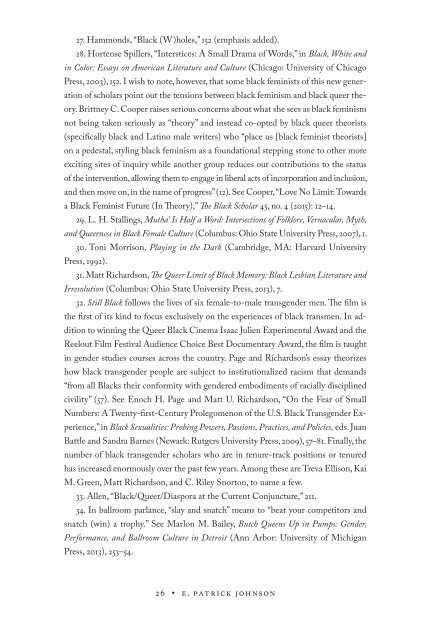No Tea
89AS6wvrf
89AS6wvrf
You also want an ePaper? Increase the reach of your titles
YUMPU automatically turns print PDFs into web optimized ePapers that Google loves.
27. Hammonds, “Black (W)holes,” 152 (emphasis added).<br />
28. Hortense Spillers, “Interstices: A Small Drama of Words,” in Black, White and<br />
in Color: Essays on American Lit er a ture and Culture (Chicago: University of Chicago<br />
Press, 2003), 152. I wish to note, however, that some black feminists of this new generation<br />
of scholars point out the tensions between black feminism and black queer theory.<br />
Brittney C. Cooper raises serious concerns about what she sees as black feminism<br />
not being taken seriously as “theory” and instead co- opted by black queer theorists<br />
(specifically black and Latino male writers) who “place us [black feminist theorists]<br />
on a pedestal, styling black feminism as a foundational stepping stone to other more<br />
exciting sites of inquiry while another group reduces our contributions to the status<br />
of the intervention, allowing them to engage in liberal acts of incorporation and inclusion,<br />
and then move on, in the name of pro gress” (12). See Cooper, “Love <strong>No</strong> Limit: Towards<br />
a Black Feminist Future (In Theory),” The Black Scholar 45, no. 4 (2015): 12–14.<br />
29. L. H. Stallings, Mutha’ Is Half a Word: Intersections of Folklore, Vernacular, Myth,<br />
and Queerness in Black Female Culture (Columbus: Ohio State University Press, 2007), 1.<br />
30. Toni Morrison, Playing in the Dark (Cambridge, MA: Harvard University<br />
Press, 1992).<br />
31. Matt Richardson, The Queer Limit of Black Memory: Black Lesbian Lit er a ture and<br />
Irresolution (Columbus: Ohio State University Press, 2013), 7.<br />
32. Still Black follows the lives of six female- to- male transgender men. The film is<br />
the first of its kind to focus exclusively on the experiences of black transmen. In addition<br />
to winning the Queer Black Cinema Isaac Julien Experimental Award and the<br />
Reelout Film Festival Audience Choice Best Documentary Award, the film is taught<br />
in gender studies courses across the country. Page and Richardson’s essay theorizes<br />
how black transgender people are subject to institutionalized racism that demands<br />
“from all Blacks their conformity with gendered embodiments of racially disciplined<br />
civility” (57). See Enoch H. Page and Matt U. Richardson, “On the Fear of Small<br />
Numbers: A Twenty-first-Century Prolegomenon of the U.S. Black Transgender Experience,”<br />
in Black Sexualities: Probing Powers, Passions, Practices, and Policies, eds. Juan<br />
Battle and Sandra Barnes (Newark: Rutgers University Press, 2009), 57–81. Fi nally, the<br />
number of black transgender scholars who are in tenure- track positions or tenured<br />
has increased enormously over the past few years. Among these are Treva Ellison, Kai<br />
M. Green, Matt Richardson, and C. Riley Snorton, to name a few.<br />
33. Allen, “Black/Queer/Diaspora at the Current Conjuncture,” 211.<br />
34. In ballroom parlance, “slay and snatch” means to “beat your competitors and<br />
snatch (win) a trophy.” See Marlon M. Bailey, Butch Queens Up in Pumps: Gender,<br />
Per for mance, and Ballroom Culture in Detroit (Ann Arbor: University of Michigan<br />
Press, 2013), 253–54.<br />
26 • E. Patrick Johnson


